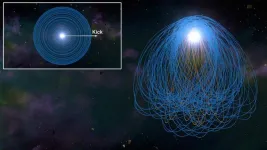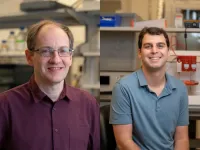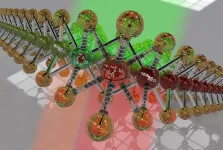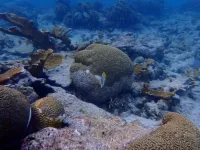(Press-News.org) Dead stars known as white dwarfs, have a mass like the Sun while being similar in size to Earth. They are common in our galaxy, as 97% of stars are white dwarfs. As stars reach the end of their lives, their cores collapse into the dense ball of a white dwarf, making our galaxy seem like an ethereal graveyard.
Despite their prevalence, the chemical makeup of these stellar remnants has been a conundrum for astronomers for years. The presence of heavy metal elements—like silicon, magnesium, and calcium—on the surface of many of these compact objects is a perplexing discovery that defies our expectations of stellar behavior.
“We know that if these heavy metals are present on the surface of the white dwarf, the white dwarf is dense enough that these heavy metals should very quickly sink toward the core,” explains JILA graduate student Tatsuya Akiba. “So, you shouldn't see any metals on the surface of a white dwarf unless the white dwarf is actively eating something.”
While white dwarfs can consume various nearby objects, such as comets or asteroids (known as planetesimals), the intricacies of this process have yet to be fully explored. However, this behavior could hold the key to unraveling the mystery of a white dwarf's metal composition, potentially leading to exciting revelations about white dwarf dynamics.
In results reported in a new paper in The Astrophysical Journal Letters, Akiba, along with JILA Fellow and University of Colorado Boulder Astrophysical and Planetary Sciences professor Ann-Marie Madigan and undergraduate student Selah McIntyre, believe they have found a reason why these stellar zombies eat their nearby planetesimals. Using computer simulations, the researchers simulated the white dwarf receiving a “natal kick” during its formation (which has been observed) caused by asymmetric mass loss, altering its motion and the dynamics of any surrounding material.
In 80% of their test runs, the researchers observed that, from the kick, the orbits of comets and asteroids within a range of 30 to 240 AU of the white dwarf (corresponding to the Sun–Neptune distance and beyond) became elongated and aligned. Furthermore, around 40% of subsequently eaten planetesimals come from counter-rotating (retrograde) orbits.
The researchers also extended their simulations to examine the white dwarf's dynamics after 100 million years. They found that the white dwarf’s nearby planetesimals still had elongated orbits and moved as one coherent unit, a result never seen before.
“This is something I think is unique about our theory: we can explain why the accretion events are so long-lasting,” states Madigan. “While other mechanisms may explain an original accretion event, our simulations with the kick show why it still happens hundreds of millions of years later.”
These results explain why the heavy metals are found on the surface of a white dwarf, as that white dwarf continuously consumes smaller objects in its path.
It’s All About Gravity
As Madigan’s research group at JILA focuses on gravitational dynamics, looking at the gravity surrounding white dwarfs seemed like a natural focus of study.
“Simulations help us understand the dynamics of different astrophysical objects,” Akiba says. “So, in this simulation, we throw a bunch of asteroids and comets around the white dwarf, which is significantly bigger, and see how the simulation evolves and which of these asteroids and comets the white dwarf eats.”
The researchers hope to take their simulations to greater scales in future projects, looking at how white dwarfs interact with larger planets.
As Akiba elaborates, “Other studies have suggested that asteroids and comets, the small bodies, might not be the only source of metal pollution on the white dwarf’s surface. So, the white dwarfs might eat something bigger, like a planet.”
Discovering More about Solar System Formation
These new findings further reveal more about the formation of white dwarfs, which is important in understanding how solar systems change over millions of years. They also help shed light on the origins and future evolution of our solar system, revealing more about the chemistry involved.
“The vast majority of planets in the universe will end up orbiting a white dwarf,” Madigan says. “It could be that 50% of these systems get eaten by their star, including our own solar system. Now, we have a mechanism to explain why this would happen.”
“Planetesimals can give us insight into other solar systems and planetary compositions beyond where we live in our solar region” McIntyre adds. “White dwarfs aren't just a lens into the past. They're also kind of a lens into the future.”
END
Hungry, hungry white dwarfs: solving the puzzle of stellar metal pollution
2024-05-03
ELSE PRESS RELEASES FROM THIS DATE:
New study reveals how teens thrive online: factors that shape digital success revealed
2024-05-03
A new study co-authored by Sophie Janicke-Bowles, associate professor in Chapman University’s School of Communication, sheds light on the role that new and traditional media play in promoting and affecting character development, emotions, prosocial behavior and well-being (aka happiness) in youth.
Her research and teaching focus on positive psychology, media and new communication technologies, and media and spirituality. The study, published April 13 in Society for Research in Child Development (SRCD), investigates how adolescents perceive ...
U of T researchers discover compounds produced by gut bacteria that can treat inflammation
2024-05-03
Researchers at the University of Toronto have found naturally occurring compounds in the gut that can be harnessed to reduce inflammation and other symptoms of digestive issues. This can be achieved by binding the compounds to an important, but poorly understood, nuclear receptor.
The gut microbiome hosts bacteria that produce compounds as by-products of feeding on our digestive remnants. The compounds can bind to nuclear receptors, which help transcribe DNA to produce proteins and non-coding RNA segments.
By identifying ...
Aligned peptide ‘noodles’ could enable lab-grown biological tissues
2024-05-03
HOUSTON – (May 3, 2024) – A team of chemists and bioengineers at Rice University and the University of Houston have achieved a significant milestone in their work to create a biomaterial that can be used to grow biological tissues outside the human body. The development of a novel fabrication process to create aligned nanofiber hydrogels could offer new possibilities for tissue regeneration after injury and provide a way to test therapeutic drug candidates without the use of animals.
The research team, led by Jeffrey Hartgerink, professor of chemistry and bioengineering, has developed peptide-based hydrogels that mimic the aligned structure of muscle and ...
Law fails victims of financial abuse from their partner, research warns
2024-05-03
Victims of financial abuse from their partner in England and Wales are being failed by an “inadequate” legal response, new research warns.
Coerced debt causes considerable harm. People often live with the effects of being forced to give money or take out loans or credit cards long after the abusive relationship has ended.
Using the law to tackle it is more complex than other forms of abuse because to be free of the harmful effects of the abuse people’s contractual liability for the debt may need to be set aside. The law often favours lenders, who have little obligation to ensure that transactions are free from coercion.
New research recommends ...
Mental health first-aid training may enhance mental health support in prison settings
2024-05-03
According to Rutgers Health researchers, training correctional officers in Mental Health First Aid (MHFA) for adults, a 7.5-hour national education program from the National Council of Mental Wellbeing, may help provide them with the necessary skills to effectively identify signs and symptoms of mental distress and advocate for incarcerated individuals facing mental health crises.
Led by Pamela Valera, an assistant professor in the Department of Urban-Global Public Health at Rutgers School of Public Health, ...
Tweaking isotopes sheds light on promising approach to engineer semiconductors
2024-05-03
Research led by scientists at the Department of Energy’s Oak Ridge National Laboratory has demonstrated that small changes in the isotopic content of thin semiconductor materials can influence their optical and electronic properties, possibly opening the way to new and advanced designs with the semiconductors.
Partly because of semiconductors, electronic devices and systems become more advanced and sophisticated every day. That’s why for decades researchers have studied ways to improve semiconductor compounds to influence how they carry electrical current. One approach is to use isotopes to ...
How E. coli get the power to cause urinary tract infections
2024-05-03
Through a quirk of anatomy, women are especially prone to urinary tract infections, with almost half dealing with one at some point in their lives.
Scientists have been trying to figure out for decades how bacteria gain a foothold in otherwise healthy people, examining everything from how the microbes move inside and stick to the inside of the bladder to how they deploy their toxins to produce uncomfortable and often painful symptoms.
Research published in PNAS examines how the bacteria Escherichia coli, or E. coli—responsible for most UTIs—is able to use host nutrients to reproduce at an extraordinarily rapid pace during ...
Quantifying U.S. health impacts from gas stoves
2024-05-03
Households with gas or propane stoves regularly breathe unhealthy levels of nitrogen dioxide, a study of air pollution in U.S. homes found.
“I didn’t expect to see pollutant concentrations breach health benchmarks in bedrooms within an hour of gas stove use, and stay there for hours after the stove is turned off,” said Stanford Doerr School of Sustainability Professor Rob Jackson, senior author of the May 3 study in Science Advances. Pollution from gas and propane stoves isn’t just an issue for cooks or people in the kitchen, ...
Physics confirms that the enemy of your enemy is, indeed, your friend
2024-05-03
Most people have heard the famous phrase “the enemy of my enemy is my friend.”
Now, Northwestern University researchers have used statistical physics to confirm the theory that underlies this famous axiom.
The study will be published on May 3 in the journal Science Advances.
In the 1940s, Austrian psychologist Fritz Heider introduced social balance theory, which explains how humans innately strive to find harmony in their social circles. According to the theory, four rules — an enemy of an enemy is a friend, a friend of a ...
Stony coral tissue loss disease is shifting the ecological balance of Caribbean reefs
2024-05-03
The outbreak of a deadly disease called stony coral tissue loss disease is destroying susceptible species of coral in the Caribbean while helping other, “weedier” organisms thrive — at least for now — according to a new study published today in Science Advances.
Researchers say the drastic change in the region’s population of corals is sure to disrupt the delicate balance of the ecosystem and threaten marine biodiversity and coastal economies.
“Some fast-growing organisms, like algae, ...







